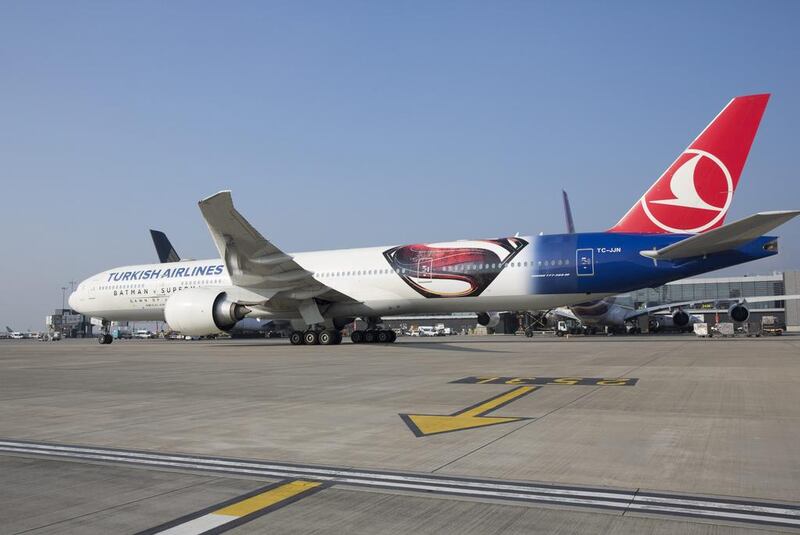Turkish Airlines claims to fly to the fictitious cities of Metropolis and Gotham City, home of Superman and Batman in the much-anticipated new superheroes movie Batman v Superman: Dawn of Justice, which opens worldwide on Friday.
But such a claim is not so far from the reality of its expansive network. The “Ottoman Empire” super connector travels to 113 countries, more than any other airline in the world, thanks to its strategic location at the crossroads of Europe, the Middle East and Asia.
With a shrewd marketing strategy and an eye on the US market, the airline is sponsoring what may be the year’s biggest commercial cinema hit, with a pivotal scene taking place aboard a Boeing 777 Turkish Airlines plane.
“Showcasing Gotham City and Metropolis as our newest US ‘destinations’ reinforces our commitment to grow Turkish Airlines’ visibility in the US, an important and growing market for the airline,” says M Ilker Ayci, the Turkish Airlines chairman.
Equally keen on the US market, Emirates last year picked the Friends TV series star Jennifer Aniston to be its brand ambassador. In the Emirates advert, the American actress wakes up to the nightmare of not having a shower and a bar on her flight. The ad can be seen as a dig at US carriers for being less luxurious than their Middle East rivals.
But putting the marketing aside, Turkish Airlines is a growing force internationally. The president of Boeing International, Bertrand-Marc Allen, says Turkey offers "a significant opportunity".
“It has got the capability, the geographic positioning, the population, the culture to be a success and a source of a lot of growth over the next 20 years. It will introduce an interesting dynamic and another competitor in this [region’s] hub strategy for aviation.
“I think that Turkey is starting to rival the UAE airlines and Turkey is doing very well,” says Mr Allen.
“We are keen to watch this develop.”
In its fleet, Turkish Airlines has 304 aircraft, with another 220 scheduled for delivery by 2021. By the end of 2016, the airline will have received another 43 aircraft, 13 of which will be wide-bodies, or twin-aisle planes. In comparison, Emirates has 234 passenger aircraft, many of them Airbus A380s, and 15 freighters in service. Etihad has 121 planes in its fleet, according to its latest fact sheet from December 2015. Qatar Airways has 171 aircraft in its fleet.
The Turkish airline flies to 284 destinations in the 113 countries it serves, with an expansive network in Africa and the US. Meanwhile, Emirates flies to 150 destinations in 80 countries. Turkish flew 60 million passengers last year. Emirates carried 49.3 million passengers in contrast. “Turkish Airlines has been a maverick when it comes to expanding its coverage. The airline operates to regions that most shy away from such as Mogadishu [in Somalia], Juba [in South Sudan] and soon, Hargeisa [in Somaliland],” says Mark Martin, the chief executive of Dubai’s Martin Consulting.
Emirates has been similarly expanding its routes in the African continent, currently flying to 27 destinations in Africa.
But the Turkish airline also has aggressive plans for this year. Its revenue target is US$12.2 billion. It aims to grow its fleet to 339 aircraft by the end of 2016, more than double its size in 2010.
In a note on Turkish Airlines n January, Capa Centre for Aviation, which provides industry research and analysis, said: “It is relatively an unusual decision to publish such detailed guidance at the start of 2016; this suggests that it is feeling confident about the year ahead.”
To accommodate this growth, Istanbul plans to open a new airport in 2018. It will serve more than 80 million passengers per year to begin with, with plans to eventually expand to 150 million at a later stage. Turkish Airlines plans for it to be the largest airport in the world, with quicker connections at the hub to help passengers reach their destinations quickly. Under the current plans, the airport will have six runways and 500 aircraft parking spots.
Still, Dubai, too, has ambitions to take the “the biggest airport project in the world” title. After the completion of Al Maktoum International at Dubai World Central in the first quarter of 2022, it will be able to accommodate more than 130 million passengers a year and accommodate 100 Airbus’ A380s at any one time. Eventually it will be capable of handling in excess of 220 million passengers a year.
Meanwhile, Abu Dhabi is also developing its Midfield Terminal complex to boost capacity at its international airport, which is set to be ready in December 2017.
However, Turkish Airlines is not exposed to threats in aviation policies that could potentially curb its growth. Last year, the American carriers Delta, United and American Airlines, claimed Arabian Gulf carriers were receiving handouts from their governments to the sum of $42bn, an allegation the Middle East airlines dismissed out of hand.
Simultaneously, the European airlines Lufthansa and Air France-KLM also take aim at Gulf carriers and in March of last year, they asked their transport ministers to urge the European Commission to look into alleged government subsidies for Gulf airlines.
Emirates said last year that it reaffirms its commitment to “open and transparent operations, free of subsidy”.
Airspace congestion is, however, a more pressing issue for Gulf airlines. Having ordered hundreds of aircraft for their rapid expansion, they are now grappling with huge fleets and limited airspace, potentially outgrowing themselves and pressuring their hub concept of connecting flights. A crowded airspace above the UAE and the wider GCC has been described by the International Air Transport Association (Iata) as one of the most serious problems facing the future growth of aviation in the region. This month, John Swift the Middle East director of Nats, an air traffic management company, said a build-up of air traffic in the Middle East skies could cost the region $16bn if nothing is done to solve the problem.
But Turkish Airlines faces a far more significant problem, according to Addison Schonland, a founder and partner of the US commercial aviation consultancy AirInsight: the location of Istanbul next to the war-torn states of neighbouring Syria and Iraq has an enormous impact on its hub ambitions.
Besides, Turkey’s tourism industry, which is crucial to the flag carrier’s growth, has been seriously dented by the spate of terrorist attacks in the capital Ankara and Istanbul recently.
“So while geographically Istanbul is easily as well placed as any of the Gulf hubs, it has to deal with the mess going on all around,” he says.
And that may ultimately prove a hurdle even Superman and Batman would struggle to overcome.
selgazzar@thenational.ae
Follow The National's Business section on Twitter





